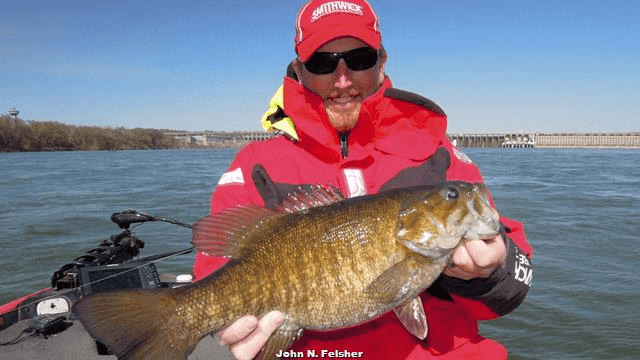The lake ranks Number 20 on the 2013 Bassmaster magazine list of the top 100 bass waters in the United States. It can produce largemouth bass exceeding 14.50 pounds, but many people think Pickwick Lake could produce the next world record smallmouth bass. The lake already delivered smallmouth exceeding 10 pounds.
“Pickwick has really become one of the best bass lakes, not only in Alabama, but in the entire South for both largemouth and smallmouth,” said Tim Horton, a professional bass angler from Muscle Shoals, Ala. “Largemouth prefer to go back into protected areas and smallmouth stay on the main river. Smallmouth like rocks more than weeds.”
On the Tennessee River, Pickwick Lake spreads through 47,500 acres across parts of Alabama, Mississippi and Tennessee. The lake runs from Wilson Dam in Florence, Ala., 53 miles downriver to Pickwick Dam at Counce, Tenn. The lake offers anglers 496 shoreline miles, including 85 island shoreline miles.
Near Wilson Dam, the lake still resembles the old river channel. The Tennessee Valley Authority maintains the channel for commercial traffic so it averages 10 to 12 feet deep. The lake spreads out as it flows toward the Mississippi-Tennessee line. Throughout the system, anglers may fish practically any cover type they wish from grassy flats to deep rocky ledges.
“Pickwick is both a river and a lake,” explained Jimmy Mason, (256-762-0014, www.jimmymasonbasspro.com) a bass pro from Rogersville, Ala., who guided on Pickwick since 2003. “At the upper part, from the Natchez Trace Bridge to Wilson Dam, it’s a river. From the bridge toward Mississippi, it turns into more of a typical reservoir. The lower lake has a phenomenal amount of ledges, grassy flats and structure.”
Although anglers frequently catch smallmouth and largemouth bass in the same spots on the same lures, smallies prefer more current, deeper water and rocky bottoms. When water flows through Wilson Dam, currents flush baitfish and other forage downstream. Many people fish right next to the dam, vertically jigging spoons or Texas rigs along the concrete. When the TVA opens some gates, but not all of them, closed gates create slack spots that attract fish. Even downstream, current from the dam positions fish.
“Typically, smallmouth go a little deeper and get in the eddies,” Mason explained. “In the winter, I like to fish close to the flow, but still outside of it. I look for anything that breaks the current, like a rock pile, sand and gravel bars or islands. I look for current seams where fish can get behind something and don’t have to fight that current.”
From the dam downstream to the Natchez Trace Bridge, the river flows around several islands, rocky shoals, sandbars and other obstructions. Some old rocky jetties that once marked the natural Tennessee River channel can hold big smallmouth.
“Those old rock rows are dynamite areas to catch smallmouth in the winter,” Mason advised. “They create great areas where fish can get out of the main flow. When the river is flowing heavy, I like to fish those rock rows. I drift backwards with the current. I use the trolling motor to slow the boat drift and cast upstream. Then, I use the current to sweep my bait into the eddies.”
Like rainbow trout in a mountain stream, bass wait in calm water behind obstructions for currents to bring prey to them. When bass see something they like, they swoop out into the current, snatch it and then return to their lairs. Since smallmouth often key on abundant threadfin shad, fish lures that simulate baitfish.
“For big smallmouth, I throw 5-inch Yum grubs on light line, about 6- to 8-pound test,” Mason said. “Heavy line catches the current and can pull a bait away from the sweet spot. With light line, the current pushes a bait into the eddy. I also throw 1-ounce Booyah spinnerbaits or Yum Money Minnow swimbaits. With the swimbait, I use a 1/2- to 1-ounce jighead, depending upon the current strength and water depth.”
Lure colors depend upon water clarity and sunshine intensity. In stained water on a sunny day, throw natural colors like pearl, blue glimmer or other shad colors. On a cloudy day with dirty water, throw brighter baits, like chartreuse, white or maybe something with a little orange.
“When the water is clear, I like to throw smoke with blue flakes,” Mason recommended. “My all-time favorite swimbait color is Foxy Shad, a shad color with a splash of chartreuse on the shoulders. That imitates a threadfin shad very well. I also throw Hologram Shad when the water is clear and the sky sunny. I’ll also throw a Tennessee shad.”
Although anglers can catch smallmouth bass from dam to dam, the area from the Natchez Trace Bridge downstream towards Mississippi typically holds more largemouth. In recent years, the lower lake sprouted with abundant hydrilla and milfoil patches, creating great largemouth habitat.
“Pickwick is a dynamite lake for big smallmouth, but in the last few years, the largemouth action has really picked up,” said Roger Stegall, (662-423-3869/www.Fishpickwick.com) a professional bass angler and guide from Iuka, Miss. “The lake produces a lot of largemouth in the 9- to 11-pound range and some bigger ones.”
For largemouth, many anglers concentrate on fishing the grass beds. During winter, punch through grass tops with jigs or work Carolina rigs over deep ledges. As weather warms, fish shad-colored topwaters near grass beds. In the spring, running a buzzing frog over grass mats can produce explosive strikes.
Yellow Creek flows into Pickwick Lake near where the Alabama, Tennessee and Mississippi State lines converge. It offers some of the best fishing on Pickwick Lake for both bass species. Other top creeks include Bear Creek, the largest tributary to the lake, Indian Creek, Dry Creek, Second Creek, Coffee Slough, Colbert Creek and Panther Creek.
Fishing on Pickwick Lake generally improves as the TVA releases water through Wilson Dam. For the Wilson Dam generator schedule, see www.tva.gov/lakes.
Tags: #FishingDestinations


